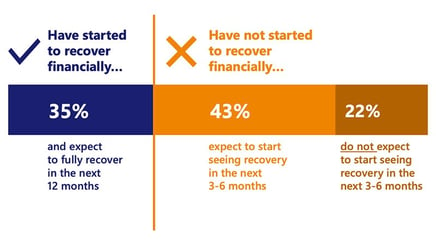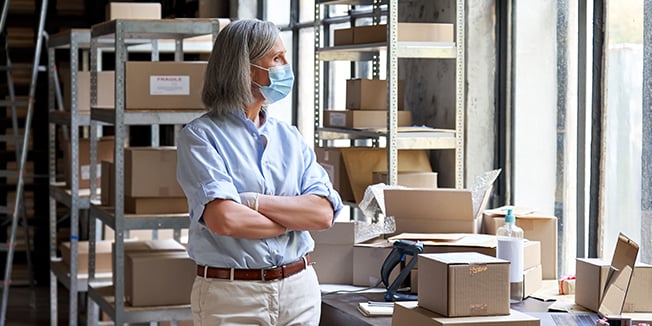6 Recommendations to Help Your Small Business Recover from COVID-19
The COVID-19 Pandemic caused many small businesses to struggle or close, and has demonstrated the importance of having a Business Continuity Plan (BCP) in place. According to the United States Small Business Administration, 90% of businesses fail within two years if they’re unable to restore their operations within 5 days after the disaster. In other words, the longer the recovery takes, the greater the risks of permanent closure.
Recovering from a disaster like COVID-19 has affected all industries, particularly those classified as a small business. According to the Washington Post, 100,000 small businesses were forced to close permanently due to the COVID-19 pandemic.

Source: Small Business Majority
COVID-19 Guidance: Getting Your Business Operations and Finances Back to Normal or to a “New Normal”
Having a Business Continuity Plan (BCP) and Disaster Recovery (DR) in place can help lessen impacts and speed recovery for returning to normal or creating a new normal.
Here are five recommendations from the Freed Maxick Risk Advisory Team for achieving these ends:
1.) Assess the Financial DamageThe first step in getting your business back to normal or to a new normal is determining how deeply your small business has been affected. While only a small number of businesses can say they benefited from the pandemic, it’s possible the damage you have incurred is not as bad as you believe. Updating financial statements can show the true affect this disaster has had on your small business, like a current and accurate profit and loss statement.
When assessing damages, you or your advisors need to factor in expenses cut during the pandemic, such as laying off employees, cutting advertising or marketing or loss of customers to competitors. Identifying these problem areas can help you rebuild faster and help recognize the areas you need to recover. For example, if you laid off employees, then you will need to assess the operating effectiveness of your current employees to determine if new employees need to be hired. Also, if you cut advertising or marketing costs you may assess whether you need to reintroduce these costs into your budget or if another approach is necessary.
2.) Take a Fresh Look at Your Business PlanWhile your business may have been successfully running pre-COVID, it’s likely that the pandemic highlighted problem areas in which you may need to fine-tune. Consider how your business needs to operate in the new normal. Looking at your competitors can give you insights as to how changing business operations can help you succeed - or not succeed - post-COVID. Your CPA or other advisors can help with strategic business planning.
3.) Get the Funding You Need to Recover
Unless you had a large amount of cash on hand prior to the pandemic, you may need some working capital to stimulate your business operations. When it comes to financing your small business during COVID, there are several options to consider, like the Paycheck Protection Program that provides funding to small businesses struggling to retain their employees.
Economic Injury Disaster Loans can also help with short-term financing for things other than employee retention. Funding is limited for these government sponsored options, therefore, talk with your CPA or other financial advisor to discuss loan options for rebuilding efforts.
 4.) Revamp Your Budget to Account for New Spending
4.) Revamp Your Budget to Account for New Spending
Everyone has heard the saying that you must spend money to make money. This is also true when rebuilding your business. You may have to spend money on hiring and training employees to function in the new normal. Inventory may need to be purchased and you may need to invest in new marketing and advertising again to draw customers back. As part of rebuilding, you should have a clear idea of what you will need in your budget and what costs can be cut to make the most out of your revenue and cash flow.
5.) Develop a Timeline for Rebuilding
You may have a list of things you want or need to do to recover from the pandemic, but prioritizing and creating a timeline for rebuilding is the best way to track, monitor and complete all of your projects. According to Infrascale, 1 in 6 small business executives don’t know their own recovery objectives.
Identifying these objectives should be reflected in your timeline for rebuilding. Your first goal should be to secure funding for your business. Once you’ve done that, setting a timeline for rehiring employees, restocking inventory, and reopening your doors should be next. Tracking your progress is a crucial step to determine if changes are necessary. You may want to start with weekly check-ins to see what’s working and what’s not. Then, you can review your financials monthly as things begin to stabilize.
Create a Contingency Plan for the Next Crisis
While the coronavirus pandemic may seem like a once-in-a-lifetime event, the reality that disasters and emergencies can happen to a business is not out of the realm of possibility. Take what you have learned from this current disaster and use it to prepare for the next crisis.
Building up liquid cash flow may be a priority if you had little or nothing set aside prior to the pandemic. You can choose to focus on debt and cost-trimming to keep your budget in check, or you may need to find ways to help your staff work more efficiently to cut operating costs. Having a Plan B can help improve your business’s odds of surviving the next disaster or emergency.
Get More Information and Guidance on COVID-19 Business Recovery Planning
The Coronavirus may have caused your small business to struggle, but it does not have to fail due to this unfortunate event. If you want to develop a Business Continuity Plan and/or Disaster Recovery, or you would like further advice on how to return your small business back to normal, we are available to help. For a complimentary consultation, please contact us via form; call me at (716) 332-2761, or email me at nicole.fitzgerald@freedmaxick.com.

